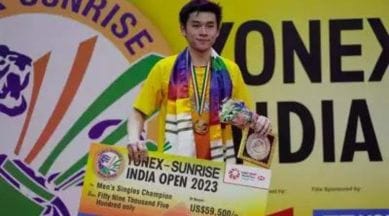Kunlavut Viditsarn finally beats Viktor Axelsen to clinch India Open Super 750
Thai Kunlavut learns from several thrashings at the hands of Axelsen to clinch India Open Super 750 title.

Not quite a coronation, or even passing of the baton, but India might well have witnessed the identifying of the princeling who can stake claim to the crown in the future.
Kunlavut Vitidsarn might’ve snouted ahead of the pack of contenders – Lakshya Sen, Kodai Naraoka and Loh Kean Yew – by doing the double – winning a Super 750 title while downing the mighty Viktor Axelsen 22-20, 10-21, 21-12.
monthly limit of free stories.
with an Express account.
In the women’s final, An Se Young turned the tables on Akane Yamaguchi, coming from behind for a 15-21, 21-16, 21-12 win taking her head-to-head to 6-10.
But the path-breaking turnaround was in the men’s singles of the India Open.
Axelsen is a tall, broad-shouldered, blue-eyed ruler of the men’s singles badminton realm for the last few years. Post the departure of Lin Dan and Lee Chong Wei, he has reigned with the sort of stranglehold that comes from not having an even rival or the odd upstart who’ll trip him up now and then in Tour finals.
Kunlavut had lost every match he’d played against Axelsen, a 6-0 margin that had some pretty deflating days. The last four losses – in straight games – had single-digit losing scores, 21-8, 21-5, 21-8, 21-6. These drubbings, though, averaged 44 minutes – each moment, one of immense learning, according to Kunlavut.
On Sunday at the IG Sports Complex, the crowd came to watch the magnificence of Axelsen. There were loud, raucous unsynchronised clappers egging him on. But there was
also artwork – a devoted fan with a cubist sketch of the roaring master, framed in artsy contours. It was the Dane’s 10th match-play day in the last 13, and he was restless and
tired. But after two easier knockouts – another single-digit swatting of Jojo Christie – he was favourite to down the upstart.
Kunlavut always had other plans. On Sunday, he also had a blueprint. “Viktor is a tall player and takes long strides on the court. So I knew if I dragged the rallies, I’d be able to tire him,” he would say.
What he did from the outset was attack at a faster clip, and force errors. It’s not the easiest things to do against Axelsen, whose defence is ace, but making the big man move back and
forth, and along the diagonal, forcing twists and turns on his backhand, in turn caused the churn which saw Kunlavut stamp his confidence and pace on the key points closing out.
A net-cord would help Kunlavut along the way in the opener, but he had shown intent in going for the jugular, guarding his leads and the floodgates opened with the first game in Kunlavut’s pocket. “It was overall not my best day attacking-wise and in my presence on the court,” Axelsen said later. Kunlavut had done his best to make the Dane feel hurried and hustled.
“Maybe, it could’ve been different had the first set gone my way,” Axelsen would say. But it was precisely this starting advantage Kunlavut had gone after.
Learning in defeat
The Thai grew up a child prone to allergies. Dealing with allergies, anyone who has countered them will tell you, is a lot of trial and error and patience. It’s also what all those single-digit scorelines would’ve taught Kunlavut, who has absorbed those drubbings against Axelsen, and used them to sharpen his game by working on weaknesses.
Sen has the defensive transitions and the cleverness. Naraoka has control and speed. Yew has the speed-plus. But it was always going to take a mix of everything, at an ever-
threatening speed, and a conscious effort to piece it all together, to stop Axelsen. And Kunlavut helped on by Axelsen’s depleting energies in Week 2 of tournament play, got a good shot at Axelsen, and made good this chance.
He had also been the first to go back to the drawing board – packed off as he was – and work hardest, of the younger lot. “This week he was the best of the (younger) lot. But let’s see how he progresses. Last week he lost to Kodai,” Axelsen would say. That three-game match, 17-21, 21-19, 17-21, had gone a stupendous 1 hour 53 minutes (Kunlavut was on court for 326 minutes, averaging 81 minutes a match).
His new regimen of running twice a week, plus six hours on court, seemed to be coming to aid. Even in the second game which he dropped knowing he was going to conserve energy for the third, he tried prolonging rallies to tire Axelsen out. In the third, the lead would keep burgeoning from 11-6 up until Kunlavut had match point.
Axelsen was feeling the effects of trying to become the invincible conqueror in different time zones – and back: Malaysia last week, India this week, and Indonesia again the next. He had also endured an emotionally-draining quarterfinal, where his good mate Rasmus Gemke snapped his Achilles, and left on a wheelchair in tears. With a young family back home and travels that are disorienting, he would end up saying, “You cannot expect that I’ll keep winning and winning and winning.”
While the All England and the World Championships in Denmark are on his radar, he would add: “Today was Kunlavut’s day.”
The Thai made the World championship final – one of those 21-5 lashings – and has battled Kento Momota in finals in Indonesia, he also made the World Tour Finals Sunday clash and has led the way in stringing together the four wins needed to earn a final spot against Axelsen. Five of his seven face-offs against Axelsen were, in fact, finals.
In New Delhi, on a cold January Sunday, he crossed the threshold, and had his first victory over Axelsen. For a title.